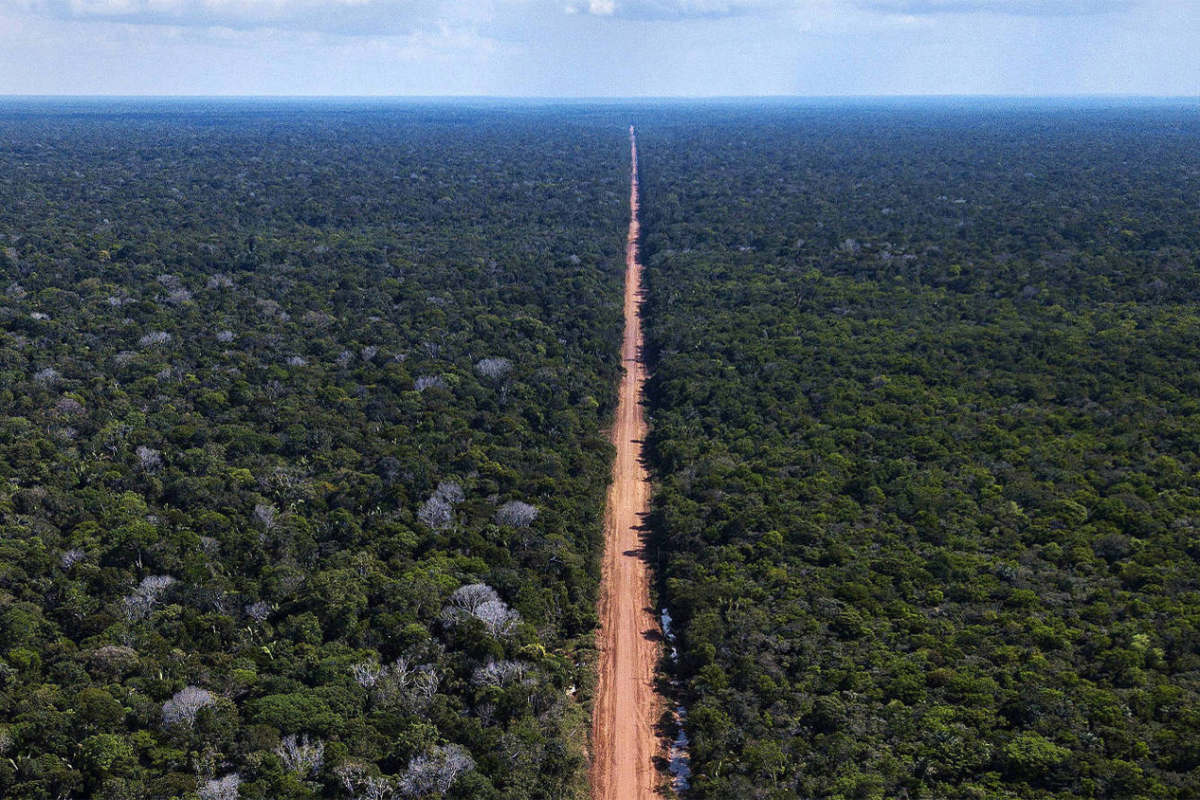- Brazil’s planned reconstruction of the BR-319 federal highway is linked to plans for five state highways and a huge oil and gas project that would open a vast area of Amazon Rainforest to deforestation.
- A new “accord” between the environment and transportation ministries would contract the drafting of a plan for governance in a strip extending 50 kilometers (31 miles) on either side of BR-319.
- The two ministries expect the accord’s “Sustainable BR-319” plan to allow environmental approval of the BR-319 reconstruction project. In doing so, it can be expected to serve as a gateway to destruction, a new op-ed argues.
- This post is a commentary. The views expressed are those of the author, not necessarily of Mongabay.
On July 15, Brazil’s Ministry of Environment and Climate Change (MMA) and the Ministry of Transportation reached an “accord” for licensing the notorious BR-319 (Manaus-Porto Velho) highway reconstruction project. The Ministry of Transportation will contract a company to perform a “strategic environmental assessment” (AAE) over eight months to recommend policies to control deforestation, strengthen local communities and “regularize” land tenure in a strip 50 kilometers (31 miles) wide along either side of the highway. Implementation of the plan will be the responsibility of the Civil House (not an environmental agency).
The environmental license for the highway reconstruction project is still pending with IBAMA (Brazilian Institute for the Environment and Renewable Natural Resources), the agency within MMA responsible for licensing, and the technical staff in IBAMA’s licensing department have repeatedly questioned the adequacy of the environmental impact study.
While considering 50 km is better than the current licensing framework, which basically only considers the roadside itself, it does not come close to reflecting the true impact of the highway reconstruction project. The impact of this federal highway will extend much further, thanks to five Amazonas state roads planned to connect to BR-319 (AM-356, AM-360, AM-464, AM-366 and AM-343) (Figure 1). AM-366 would extend 574 km (357 miles) to the west of BR-319, opening the vast Trans-Purus region to the west of the Purus River to deforesters.
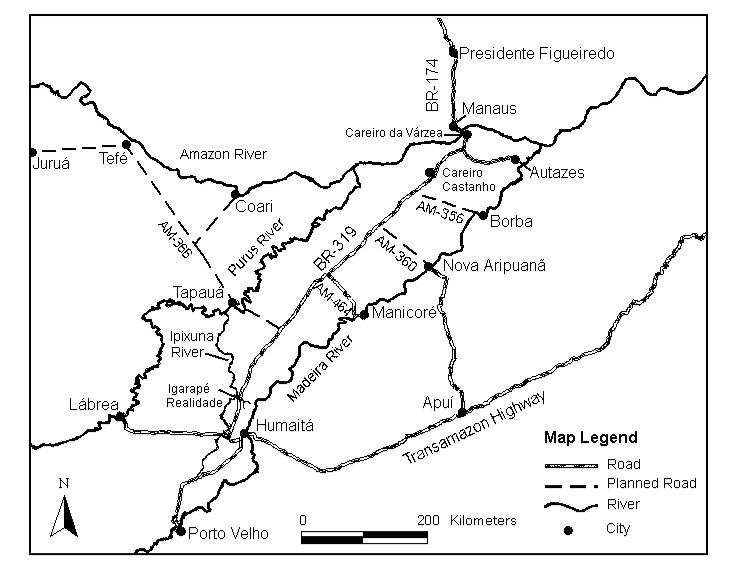
The area along the planned AM-366 and AM-343 that branches off it has already been claimed by large land grabbers (Figure 2) by means of self-declared entries in the Rural Environmental Register (CAR), which has become a major tool for grabbing of government land (see here, here and here). Agribusiness entrepreneurs in AMACRO (the border region between the states of Amazonas, Acre and Rondônia) are planning to target exactly the area to be opened by AM-366 after they finish deforesting the AMACRO region. Presumably, they would buy the land claims from the land grabbers who are anticipating the opening of the road.
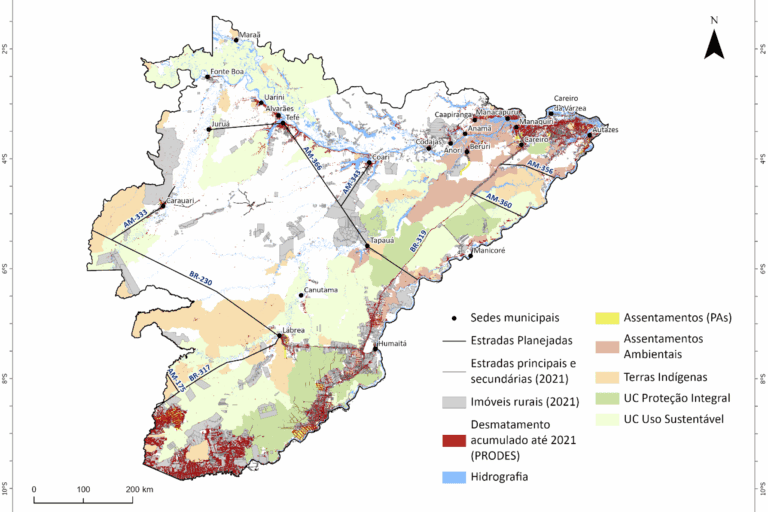
The area to be opened by AM-366 is also the location of the enormous proposed “Solimões Sedimentary Area” oil and gas project (see here and here) (Figure 3). Drilling rights to first blocks, three of which are crossed by the AM-366 route, have already been sold to Rosneft, the giant Russian oil company that Greenpeace Russia accuses of causing more than 10,000 oil spills around the world. Both financial and political influence is likely to result in priority for building AM-366, given that it is much cheaper to have road access to the oil and gas fields than to fly between them by helicopter as if they were platforms at sea (the official plan). The governor of Amazonas, Wilson Lima, supports Rosneft’s plans as a “priority enterprise for the state.” This is likely to both facilitate the state government licensing for AM-366 and lead to the state government spending its taxpayers’ money on building this road that would benefit the company.
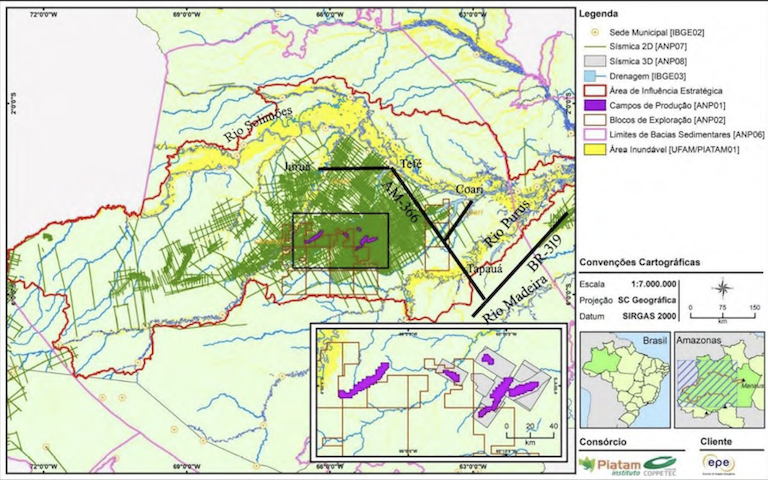
As state highways, the six “AM” roads would be licensed by the Instituto de Proteção Ambiental do Amazonas (IPAAM), the state government’s environmental agency. Like other states, the environmental agency in Amazonas is not independent of the governor. State environmental agencies are much more easily influenced than the federal agency. IBAMA. This was dramatically demonstrated in 2017 when illegal gold miners from the Madeira River set fire to the offices of IBAMA and ICMBio (the agency under MMA responsible for protected areas) in Humaitá (Figure 4). The governor of Amazonas took the head of IPAAM to Humaitá and announced that the gold miners would be granted licenses to continue mining. A few days later, IPAAM granted the licenses, rewarding the miners for their crimes.
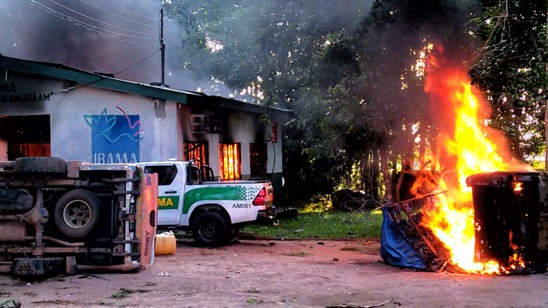
Orders from the governor are not the only way that state agencies can be influenced. In the current scandal known as “Operation Greenwashing,” IPAAM approved illegal forest management plans in “undesignated public lands” as part of a scheme that included 538,000 hectares (more than 1.3 million acres) of land grabbing and $38 million in bogus carbon credits. The heads of three departments in IPAAM were arrested in December 2024 and the president of the agency was removed from his post (see here, here and here).
It is essential to recognize that the state government’s roads and other plans linked to BR-319 are integral parts of the project’s impact. Federal government decision-makers and licensers cannot pretend that only the edges of the federal highway itself are of their concern. This bureaucratic view, the root of what historian Hannah Arendt famously termed the “banality of evil,” is a formula for an environmental disaster of a magnitude with few rivals anywhere in the world (see here, here, here and here). The plans beyond the roadside itself would not exist were it not for the BR-319 reconstruction project.
The influential lobbying group “Friends of BR-319” (“Amigos da BR-319”) has made clear that it wants not only the BR-319 but also the “Trans-Purus Highway,” that is, AM-366. Once the reconstruction of BR-319 is completed, AM-366 and other plans would follow automatically, essentially. One must also be minimally realistic regarding the current governor of Amazonas (Figure 5); the chance that he would realize that the impact of AM-366 would be too great to allow is zero. Likewise, the chance that the state government’s environmental agency would refuse to license this project is also essentially zero.

The July 15 accord between MMA and the Ministry of Transportation was celebrated by the governor of Amazonas as ensuring a speedy approval of the BR-319 reconstruction project. After more than two decades of being constantly deluged with misinformation on the impacts and benefits of BR-319, it is no surprise that a large majority of the population of Manaus supports the reconstruction project. Opposing the project would be political suicide for any local politician, and they compete to take credit for obtaining the project’s approval. A vicious circle leads to ever more exaggerated rhetoric in support of the project and greater support for it by the electorate.
During the July 17, 2025, final vote in the federal Chamber of Deputies approving the “Bill of Devastation” to largely dismantle the federal licensing system (see here and here), only one of the eight deputies from Amazonas opposed the bill, with statements from those in favor (all from the “Centrão” voting block) invariably citing the bill’s likely result of a speedy approval of the BR-319 project. Particularly attractive were the amendments that had been inserted into it by the Senate that removed any requirement for licensing for a road that had been paved in the past (i.e., BR-319) and that created a “special environmental license” that would force approval of “strategic” projects within one year, regardless of the magnitude of their impacts.

The new accord implies that the highway reconstruction project will be approved on the basis of a plan for governance in the area within 50 km of BR-319. This plan barely touches the impact of the highway, even if the promised governance were 100% successful.
First, it should be noted that a plan is not the same as actually having governance. The relevant example is the Sustainable BR-163 Plan, which served as the basis for approving reconstruction of the Santarém-Cuiabá highway in 2005. Instead of becoming the promised “corridor of sustainable development,” this highway instead became a major focus of illegal deforestation, logging, gold mining, invasion of Indigenous areas and land grabbing, and it was the ranchers there who organized the “day of fire” in 2019 to show support for then-president Jair Bolsonaro’s antienvironmental policies.
Ironically, BR-163 is presented by the highway department as a model of governance for BR-319. More basic than the realism of the plans for governance, which are clearly desirable in their own right, is that these plans have the ironic role of serving as an excuse for approving projects whose impacts far exceed any gains from the governance measures themselves, resulting in a net negative outcome.
Philip M. Fearnside is a research professor at the National Institute for Research in Amazonia (INPA), Manaus, Amazonas, Brazil.
This article is an updated translation of a text by the author that is available in Portuguese on Amazônia Real.
Related audio from Mongabay’s podcast: Author and storytelling expert Tsering Yangzom Lama discusses how to shape narratives to change society and the environment, listen here:
See related coverage:
Brazil police raid Amazon carbon credit projects exposed by Mongabay
Citations:
Fearnside, P. M., & de Alencastro Graça, P. M. L. (2006). BR-319: Brazil’s Manaus-Porto Velho Highway and the potential impact of linking the arc of deforestation to central Amazonia. Environmental management, 38(5), 705-716. doi:10.1007/s00267-005-0295-y
Fearnside, P. M., & Graça, P. M. L. A. (2009). BR-319: A rodovia Manaus-Porto Velho e o impacto potencial de conectar o Arco de desmatamento à Amazônia central. Novos Cadernos NAEA, 12(1). doi:10.5801/ncn.v12i1.241
Azevedo-Ramos, C., Moutinho, P., Arruda, V. L. D. S., Stabile, M. C., Alencar, A., Castro, I., & Ribeiro, J. P. (2020). Lawless land in no man’s land: The undesignated public forests in the Brazilian Amazon. Land Use Policy, 99, 104863. doi:10.1016/j.landusepol.2020.104863
Brito, B., Barreto, P., Brandão Jr., A., Baima, S., & Gomes, P. H. (2019). Stimulus for land grabbing and deforestation in the Brazilian Amazon. Environmental Research Letters, 14(6), 064018. doi:10.1088/1748-9326/ab1e24
Carrero, G. C., Walker, R. T., Simmons, C. S., & Fearnside, P. M. (2022). Land grabbing in the Brazilian Amazon: Stealing public land with government approval. Land Use Policy, 120, 106133. doi:10.1016/j.landusepol.2022.106133
Fearnside, P. M. (2022). Amazon environmental services: Why Brazil’s Highway BR-319 is so damaging. Ambio, 51(6), 1367-1370. doi:10.1007/s13280-022-01718-y
Source link
#Brazils #licensing #accord #gateway #forest #destruction #BR319 #highway #commentary
